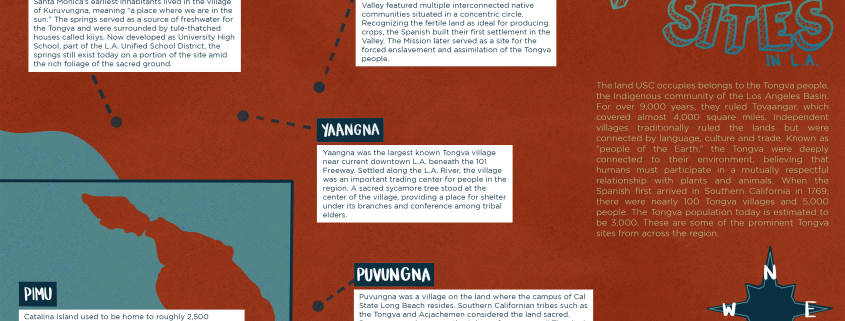Significant Tongva sites in Los Angeles

The land USC occupies belongs to the Tongva people, the Indigenous community of the Los Angeles Basin. For over 9,000 years, they ruled Tovaangar, which covered almost 4,000 square miles. Independent villages traditionally ruled the lands but were connected by language, culture and trade. Known as “people of the Earth,” the Tongva were deeply connected to their environment, believing that humans must participate in a mutually respectful relationship with plants and animals. When the Spanish first arrived in Southern California in 1769, there were nearly 100 Tongva villages and 5,000 people. The Tongva population today is estimated to be 3,000. These are some of the prominent Tongva sites from across the region.
Kuruvungna Sacred Springs:
Santa Monica’s earliest inhabitants lived in the village of Kuruvungna, meaning “a place where we are in the sun.” The springs served as a source of freshwater for the Tongva and were surrounded by tule-thatched houses called kiiys. Now developed as University High School, part of the L.A. Unified School District, the springs still exist today on a portion of the site amid the rich foliage of the sacred ground.
Yaangna:
Yaangna was the largest known Tongva village near current downtown L.A. beneath the 101 Freeway. Settled along the L.A. River, the village was an important trading center for people in the region. A sacred sycamore tree stood at the center of the village, providing a place for shelter under its branches and conference among tribal elders.
San Gabriel Mission:
Before the arrival of the Spanish, the San Gabriel Valley featured multiple interconnected native communities situated in a concentric circle. Recognizing the fertile land as ideal for producing crops, the Spanish built their first settlement in the Valley. The Mission later served as a site for the forced enslavement and assimilation of the Tongva people.
Pimu:
Catalina Island used to be home to roughly 2,500 members of the Tongva tribe. The tribe utilized flaura, fauna, fresh water and copious marine life on the island. They established small villages where Avalon, Two Harbors and Toyon Bay are now located. Families created effective food systems using the resources around them. Men hunted the wild game while women gathered seeds, berries and other items provided by the land.
Puvungna:
Puvungna was a village on the land where the campus of Cal State Long Beach resides. Southern Californian tribes such as the Tongva and Acjachemen considered the land sacred. Puvungna was known as the “place of emergence.” The site is considered more than a village because it was also a gathering place and an active intertribal ceremonial site. Five hundred acres and more than a dozen archaeological sites have been attributed to Puvungna village sites, but most have been decimated and built over by development.

